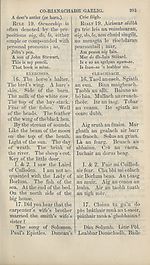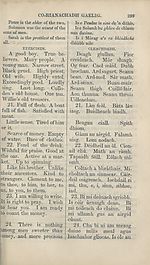Books and other items printed in Gaelic from 1841 to 1870 > Double grammar, of English and Gaelic, in which the principles of both languages are clearly explained
(298) Page 298 [i.e. 296]
Download files
Complete book:
Individual page:
Thumbnail gallery: Grid view | List view
![(298) Page 298 [i.e. 296] -](https://deriv.nls.uk/dcn17/1065/4334/106543343.17.jpg)
298
GAELIC CONSTRUCTION.
sanntach, deidheil, cronail, iarrtach, cairdeil,
rach, miannach
iochdail.
Of Profit—math, feumail, buannachail, tarbhach, coromach,
sgileil, eolach, teoma, seolta, tapaidh, baigheil, buailteacb.
Of Likeness—amhuil, coslach, cosmhal, ionann, co-ionann, &c.
Of Proximity—fagus, fogus, dliith.
Of Kindness—baigheil, blath, cairdeil, caomh, caomhail, caoin-
eil, daimheil, fabharach, fiughantacb, math, tlusail, &c.
Rule 23. — Adjectives
signifying volition or readi¬
ness, and their opposites,
govern the infinitive ; as,
Willing to learn.
Ready to strike thee.
Rule 24.—The Compa¬
rative degree of adjectives,
with the Verb Bi, requires
na’s or ms* immediately
before it, and na after it
whenobjects are compared;
as.
My knife is sharper than your
knife.
They are sweeter than the
honey.
Rialt. 23.—Spreigeadh
buadharan a’ ciallaehadh
toile no deise, agusan luchd-
aghaidhamFeartach; mar,
Toileaeh ionnsachadh.
Ullamh gu do bhualadh.
Rialt. 24. — Gabhaidh
ceum coimeasach bhuadh-
aran leis a’ Ghuiomhar Bi,
n as no ni's* din roimhe,
agus na din ’na dheigh
’nuair a choimeasar cusp-
airean ; mar,
Tha mo sgian-sa na’s geire
na do sgian-sa.
Ni's milse na a’ mhil a ta
iad
1. The Comparative, with the Verb Is, takes only na after the
first object; as, Is fearr gliocas na ’n t-or, wisdom is better than,
gold. Bu luaithe iad na iolairean, they were swifter than eagles.
2. The English Comparative preceded by the definite article,
is rendered in Gaelic by mar, is, and ann; thus, mar is luaithe
’s aim is feair, the sooner the better ; mar is sine’s aim is miosa.
Rule 25.—Both tho com¬
parative and superlative are
followed by de, when selec¬
tion is implied ; as,
Rialt. 25.—Cuirear de
an deigh a’ choimeasaich
agus an Anardaich, ’nuair
a dh-ainmichear roghann ;
mar,
* Contracted lor na is and ni is, and pronounced nas, nis; na's is most com¬
monly used in the spoken, and ni's in the written language.
Na's and ni's drop the’s before bu or b'; as, Bha iad na bu ghile, they trei'e
■whiter. Bha e ni b’ eolaiche,'/^? was more skilful; hence there is reason to con¬
clude that 's after na and ni is from the verb is, seeing bu, its past rejects it.
GAELIC CONSTRUCTION.
sanntach, deidheil, cronail, iarrtach, cairdeil,
rach, miannach
iochdail.
Of Profit—math, feumail, buannachail, tarbhach, coromach,
sgileil, eolach, teoma, seolta, tapaidh, baigheil, buailteacb.
Of Likeness—amhuil, coslach, cosmhal, ionann, co-ionann, &c.
Of Proximity—fagus, fogus, dliith.
Of Kindness—baigheil, blath, cairdeil, caomh, caomhail, caoin-
eil, daimheil, fabharach, fiughantacb, math, tlusail, &c.
Rule 23. — Adjectives
signifying volition or readi¬
ness, and their opposites,
govern the infinitive ; as,
Willing to learn.
Ready to strike thee.
Rule 24.—The Compa¬
rative degree of adjectives,
with the Verb Bi, requires
na’s or ms* immediately
before it, and na after it
whenobjects are compared;
as.
My knife is sharper than your
knife.
They are sweeter than the
honey.
Rialt. 23.—Spreigeadh
buadharan a’ ciallaehadh
toile no deise, agusan luchd-
aghaidhamFeartach; mar,
Toileaeh ionnsachadh.
Ullamh gu do bhualadh.
Rialt. 24. — Gabhaidh
ceum coimeasach bhuadh-
aran leis a’ Ghuiomhar Bi,
n as no ni's* din roimhe,
agus na din ’na dheigh
’nuair a choimeasar cusp-
airean ; mar,
Tha mo sgian-sa na’s geire
na do sgian-sa.
Ni's milse na a’ mhil a ta
iad
1. The Comparative, with the Verb Is, takes only na after the
first object; as, Is fearr gliocas na ’n t-or, wisdom is better than,
gold. Bu luaithe iad na iolairean, they were swifter than eagles.
2. The English Comparative preceded by the definite article,
is rendered in Gaelic by mar, is, and ann; thus, mar is luaithe
’s aim is feair, the sooner the better ; mar is sine’s aim is miosa.
Rule 25.—Both tho com¬
parative and superlative are
followed by de, when selec¬
tion is implied ; as,
Rialt. 25.—Cuirear de
an deigh a’ choimeasaich
agus an Anardaich, ’nuair
a dh-ainmichear roghann ;
mar,
* Contracted lor na is and ni is, and pronounced nas, nis; na's is most com¬
monly used in the spoken, and ni's in the written language.
Na's and ni's drop the’s before bu or b'; as, Bha iad na bu ghile, they trei'e
■whiter. Bha e ni b’ eolaiche,'/^? was more skilful; hence there is reason to con¬
clude that 's after na and ni is from the verb is, seeing bu, its past rejects it.
Set display mode to:
![]() Universal Viewer |
Universal Viewer | ![]() Mirador |
Large image | Transcription
Mirador |
Large image | Transcription
Images and transcriptions on this page, including medium image downloads, may be used under the Creative Commons Attribution 4.0 International Licence unless otherwise stated. ![]()
| Permanent URL | https://digital.nls.uk/106543341 |
|---|
| Description | Out-of-copyright books printed in Gaelic between 1631 and 1900. Also some pamphlets and chapbooks. Includes poetry and songs, religious books such as catechisms and hymns, and different editions of the Bible and the Psalms. Also includes the second book ever published in Gaelic in 1631. |
|---|

